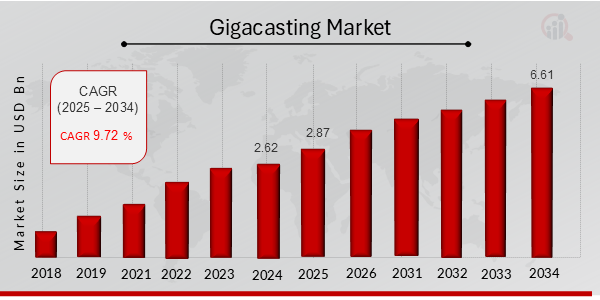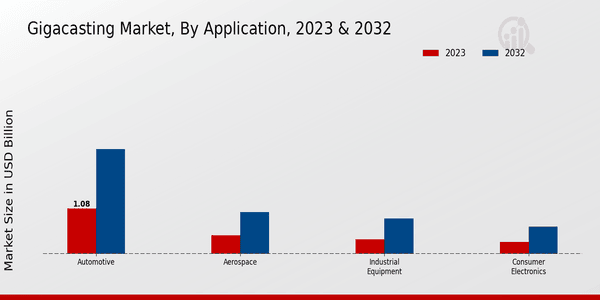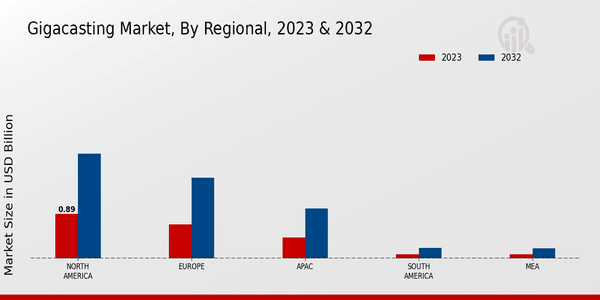Gigacasting Market Overview:
As per MRFR analysis, the Gigacasting Market Size was estimated at 2.62 (USD Billion) in 2024. The Gigacasting Market Industry is expected to grow from 2.87 (USD Billion) in 2025 to 6.61 (USD Billion) till 2034, at a CAGR (growth rate) is expected to be around 9.72% during the forecast period (2025 - 2034).
Key Gigacasting Market Trends Highlighted
The Gigacasting Market is witnessing a significant transformation driven by the push for cost efficiency and sustainability in manufacturing processes. As automakers strive to reduce production costs and achieve faster turnaround times, gigacasting technology stands out by allowing seamless integration of multiple components into single parts. This approach reduces the number of manufacturing steps, thereby saving time and resources. Additionally, the increasing demand for lightweight and more durable materials in electric vehicles is further accelerating the adoption of gigacasting, as these components can deliver enhanced performance without compromising quality.
Opportunities within the gigacasting market are abundant, particularly as industries continue to embrace automation and advanced manufacturing techniques. The rising interest in electric vehicles signifies a substantial opportunity for gigacasting to streamline production processes and improve the overall supply chain efficiency. Companies that invest in this technology are likely to gain a competitive edge by responding swiftly to consumer demands while minimizing material waste. Furthermore, the potential for partnerships between technology providers and traditional automotive manufacturers can lead to innovative solutions that drive growth in this sector.
Recent trends indicate a surge in investments toward research and development within gigacasting technologies. Companies are continually exploring advancements that can enhance the accuracy and speed of the casting process. Additionally, the integration of artificial intelligence and machine learning in quality control processes is becoming more prominent, ensuring higher standards for finished products. This focus on technological innovation underlines the market's evolution as it adapts to changing consumer preferences and environmental regulations, paving the way for a more sustainable future in vehicle manufacturing.

Source: Primary Research, Secondary Research, MRFR Database and Analyst Review
Gigacasting Market Drivers
Increased Demand for Electric Vehicles
The shift towards electric vehicles (EVs) is one of the primary drivers propelling the growth of the Gigacasting Market Industry. As governments worldwide enforce stricter emissions regulations and promote sustainable transportation, consumers are increasingly leaning towards electric mobility solutions. Gigacasting technology, which allows for the production of large, complex vehicle components in a single cast, provides manufacturers with the ability to produce lighter, more efficient parts.
This not only streamlines production processes but also significantly reduces manufacturing costs, an essential factor as competition in the EV market heats up among various automakers. The ability to produce components that are both cost-effective and high-performing enhances the competitiveness of vehicle manufacturers in a landscape increasingly defined by innovation and efficiency. Moreover, consumers are demanding vehicles that offer improved range and battery performance, which means manufacturers must look for innovative ways to enhance the structural integrity and reduce the weight of EVs.
Gigacasting provides a viable solution for the automotive sector's evolving needs, driving further adoption and integration of this technology in vehicle production. As the trend toward EVs continues and gains momentum, the influence of gig-casting technology is expected to grow substantially, showcasing its pivotal role in meeting the industry's transforming requirements and supporting the wider adoption of electric vehicles globally.
Cost-Effectiveness of Production
The Gigacasting technology offers a transformative approach to manufacturing that significantly reduces production costs. This cost-effectiveness is achieved through fewer components needed for assembly, thereby reducing labor costs and minimizing waste of materials during the manufacturing process. As manufacturers strive to improve profit margins and optimize operations, the Gigacasting Market Industry serves as a key asset. This aspect of gigacasting technology not only facilitates swift production cycles but also enhances economies of scale, positioning companies to respond swiftly to market demands.
The capacity to produce larger components more efficiently represents a vital advantage in budget management for automotive makers aiming for profitability in competitive markets.
Technological Advancements in Manufacturing
The rapid pace of technological advancements in manufacturing processes is fueling the growth of the Gigacasting Market Industry. With innovations such as automation, artificial intelligence, and advanced materials, manufacturers are now able to implement gigacasting more effectively and efficiently. This evolution enables them to produce complex vehicle parts with precision while maintaining high production speeds. As a result, organizations can ensure higher quality and better performance in their final products.
These advancements further attract investments into the gigacasting sphere, fostering an environment ripe for growth and expansion in the coming years.
Gigacasting Market Segment Insights:
Gigacasting Market Application Insights
The Global Gigacasting Market, valued at 2.17 USD Billion in 2023, showcases a diverse portfolio of applications that underline its significance across different industries. The market is projected to reach 5.0 USD Billion by 2032, reflecting robust industry growth and dynamism primarily driven by technological advancements and increasing manufacturing efficiency. The Automotive sector is a major contributor in this landscape, holding a valuation of 1.08 USD Billion in 2023 and expected to grow to 2.5 USD Billion by 2032. This sector dominates the market due to the rising demand for lightweight and energy-efficient vehicles, which promotes the adoption of advanced casting technologies. In contrast, the Aerospace segment maintains a significant role within the market, valued at 0.45 USD Billion in 2023 and anticipated to grow to 1.0 USD Billion by 2032. This steady growth is attributed to the sector's focus on enhancing aircraft performance and reducing weight, where gigacasting proves instrumental.
Additionally, the Industrial Equipment application valued at 0.35 USD Billion in 2023 and projected to expand to 0.85 USD Billion in 2032, reflects the need for durable and high-precision components that improve operational efficiency in manufacturing processes. This segment's growth is driven by the increasing automation within industries where gigacasting technologies provide both performance and cost-efficiency advantages. Meanwhile, the Consumer Electronics segment, valued at 0.29 USD Billion in 2023 and expected to reach 0.65 USD Billion by 2032, highlights the market's adaptability to changing consumer preferences, emphasizing lightweight and efficient production techniques. The demand for compact and high-performing electronic devices necessitates advanced casting methods, making this application increasingly relevant.
Overall, the market growth across these diverse applications reflects the transformative potential of gigacasting technologies in enhancing manufacturing efficacy, reducing production costs, and meeting evolving consumer and industry demands. Growth drivers include the push for sustainable practices, the need for operational efficiencies, and advancements in casting technologies, which collectively offer numerous opportunities for stakeholders in the Global Gigacasting Market.

Source: Primary Research, Secondary Research, MRFR Database and Analyst Review
Gigacasting Market Material Insights
The Gigacasting Market revenue is projected to reach 2.17 USD Billion in 2023, reflecting the increasing demand for efficient manufacturing processes. Material segmentation in this market includes notable categories like Aluminum, Steel, Magnesium, and Plastic, each contributing uniquely to the industry. Aluminum holds a significant position due to its lightweight properties and versatility, making it a preferred choice for various applications. Steel, recognized for its strength and durability, is also essential for heavy-duty casting needs.
Magnesium stands out for applications requiring reduced weight without sacrificing structural integrity, giving it a competitive edge in sectors like automotive. Plastic, while less common, is gaining traction for specific lightweight and corrosion-resistant applications. The overall market is set to grow as advancements in material technology and casting techniques enhance efficiency and performance across these segments, addressing challenges like cost and environmental impact while creating opportunities for innovation and sustainable practices.
Thus, the Gigacasting Market statistics reflect a dynamic landscape driven by diverse material demands and technological evolution.
Gigacasting Market Process Type Insights
The Global Gigacasting Market, projected to reach a value of 2.17 USD billion in 2023, showcases a diverse range of process types that contribute significantly to its overall growth. Within this market, methods such as Die Casting, Sand Casting, Investment Casting, and Continuous Casting play crucial roles. Die Casting, known for its ability to produce complex shapes with high precision, is particularly popular in the automotive industry, underlining its importance in delivering lightweight yet robust components. Sand Casting retains its relevance due to its flexibility and lower costs, making it a preferred choice for many manufacturers.
Investment Casting offers enhanced surface finishes and intricate shapes, appealing to industries demanding high-quality standards. Continuous Casting, while less prevalent, is valuable for producing long metal products, thereby catering to specific industrial needs. The overall market is expected to experience robust growth, driven by innovations in casting technologies, increasing demand for lightweight components, and a focus on sustainable manufacturing processes. However, the industry faces challenges, including skilled labor shortages and fluctuating raw material prices, which require strategic planning to navigate effectively.
The Gigacasting Market statistics reflect an evolving landscape, pointing to opportunities for growth across various sectors as these process types adapt to changing market demands
Gigacasting Market End Use Industry Insights
The Gigacasting Market is witnessing robust growth, projected to reach a valuation of 2.17 USD Billion in 2023. The market's segmentation along the End Use Industry highlights various critical sectors, including Transportation, Construction, Manufacturing, and Energy. The Transportation sector holds significant importance, driven by the increasing demand for electric vehicle components. In the Construction industry, gigacasting technologies are enhancing efficiency and reducing costs, leading to a notable impact on large-scale projects. The Manufacturing sector is also experiencing a shift towards automation and precision casting techniques, facilitating better production capabilities.
The Energy sector is evolving with gigacasting methods serving sustainable energy solutions, underpinning the global shift towards renewable sources. These insights underscore the transformative role of gigacasting across diverse industries, contributing to the overall Gigacasting Market revenue and setting a foundation for substantial market growth in the coming years.
Gigacasting Market Regional Insights
The Gigacasting Market revenue has been steadily growing, with the market projected to be valued at 2.17 USD Billion in 2023 and increasing to 5.0 USD Billion by 2032. In this landscape, North America holds a majority share, valued at 0.89 USD Billion in 2023 and expected to reach 2.09 USD Billion by 2032, driven by advancements in manufacturing technology and increasing demand for electric vehicles. Europe follows with a valuation of 0.68 USD Billion in 2023, anticipating growth to 1.61 USD Billion by 2032, reflecting the region's commitment to sustainability and innovation.
The APAC region shows potential, starting at 0.42 USD Billion in 2023 and growing to 1.0 USD Billion by 2032, as it becomes a hub for automotive production. South America and MEA appear to be in the nascent stages, with valuations of 0.09 USD Billion and 0.09 USD Billion in 2023, respectively, expected to reach 0.21 USD Billion and 0.2 USD Billion in 2032, indicating opportunities for market expansion. The Gigacasting Market statistics suggest that factors like technological advancements, robust manufacturing frameworks, and evolving automotive needs are substantial growth drivers, while challenges may include competition and capital investment.

Source: Primary Research, Secondary Research, MRFR Database and Analyst Review
Gigacasting Market Key Players and Competitive Insights:
The Gigacasting Market is witnessing dynamic shifts driven by advancements in manufacturing technologies and increasing demand for efficient production processes. As industries explore innovative solutions to enhance their operational capabilities, the competitive landscape is characterized by a variety of organizations vying for market share through strategic collaborations, technological advancements, and robust supply chain networks. The market's potential is buoyed by the need for lightweight components and complex geometries in sectors such as automotive, aerospace, and consumer products. This competitive environment has fostered innovation, positioning companies to capitalize on the precision and speed offered by gig casting techniques, thus changing traditional casting paradigms and redefining production methodologies.
SPEE3D stands out in the Gigacasting Market due to its pioneering approach to metal printing and component production. The company's strengths lie in its unique technology that enables rapid manufacturing with reduced lead times and lower material costs, thus creating significant advantages in the production of complex parts. SPEE3D employs a proprietary Cold Spray technology that allows for the production of large-scale components in a fraction of the time compared to conventional methods. This capability not only enhances production efficiency but also supports sustainability efforts by minimizing waste and energy consumption. SPEE3D's commitment to innovation and its ability to cater to a diverse range of industries, including automotive and aerospace, reinforce its market presence and contribute to its competitive positioning in the gigacasting landscape.
In the context of the Global Gigacasting Market, 3D Systems has emerged as a formidable player, leveraging its extensive experience in 3D printing and additive manufacturing technologies. Known for its comprehensive portfolio of solutions, 3D Systems focuses on delivering high-quality, precision-engineered components that meet the evolving demands of industries seeking to optimize production processes. The company emphasizes scalability, allowing it to cater to both prototyping needs and large-scale production runs, which is crucial for customers aiming to harness gigacasting efficiencies. With a deep understanding of material properties and advanced printing techniques, 3D Systems is well-positioned to provide innovative solutions that support product development cycles and bolster manufacturing capabilities. Its commitment to advancing additive manufacturing technology places it in a strategic position to capitalize on the opportunities presented by the gig casting market.
Key Companies in the Gigacasting Market Include:
- SPEE3D
- 3D Systems
- Velo3D
- Giga Casting
- Eisenmann
- ExOne
- Tesla
- IDRA Group
- Caterpillar
- Fives Group
- KUKA AG
- Georg Fischer
- Additive Industries
- Aluminum Systems
Gigacasting Market Industry Developments
Recent developments in the Gigacasting Market indicate a surge in technological advancements and investments aimed at enhancing production capabilities. Companies such as Tesla continue to lead with innovations in large-scale aluminum casting processes, significantly reducing production times and costs. The collaboration between IDRA Group and Tesla has been pivotal, particularly with the latter's focus on Gigacasting plants for Model Y production. Additionally, manufacturers like 3D Systems and Velo3D are pushing boundaries with advanced metal 3D printing technologies, which complement traditional casting methods.
Current affairs highlight rising demands for faster and more efficient manufacturing processes, particularly within electric vehicle production, which is increasing the market valuation of involved companies. Notable mergers and acquisitions include Eisenmann's strategic partnership with Caterpillar, focusing on targeted gig casting advancements, and Fives Group's efforts towards integration with various additive manufacturing firms. As the market evolves, companies are experiencing significant growth and restructuring to adapt to new technologies, creating a ripple effect that impacts the larger manufacturing landscape.
Gigacasting Market Segmentation Insights
- Gigacasting Market Application Outlook
- Automotive
- Aerospace
- Industrial Equipment
- Consumer Electronics
- Gigacasting Market Material Outlook
- Aluminum
- Steel
- Magnesium
- Plastic
- Gigacasting Market Process Type Outlook
- Die Casting
- Sand Casting
- Investment Casting
- Continuous Casting
- Gigacasting Market End Use Industry Outlook
- Transportation
- Construction
- Manufacturing
- Energy
- Gigacasting Market Regional Outlook
- North America
- Europe
- South America
- Asia Pacific
- Middle East and Africa
| Report Attribute/Metric |
Details |
|
Market Size 2024
|
2.62 (USD Billion)
|
|
Market Size 2025
|
2.87 (USD Billion)
|
|
Market Size 2034
|
6.61 (USD Billion)
|
|
Compound Annual Growth Rate (CAGR)
|
9.72% (2025 - 2034)
|
|
Report Coverage
|
Revenue Forecast, Competitive Landscape, Growth Factors, and Trends
|
|
Base Year
|
2024
|
|
Market Forecast Period
|
2025 - 2034
|
|
Historical Data
|
2019 - 2023
|
| Market Forecast Units |
USD Billion |
| Key Companies Profiled |
SPEE3D, 3D Systems, Velo3D, Giga Casting, Eisenmann, ExOne, Tesla, IDRA Group, Caterpillar, Fives Group, KUKA AG, Georg Fischer, Additive Industries, Aluminum Systems |
| Segments Covered |
Application, Material, Process Type, End Use Industry, Regional |
| Key Market Opportunities |
Increasing electric vehicle production, Rising demand for lightweight components, Advances in metal casting technology, Growing focus on sustainable manufacturing, Expansion into emerging markets |
| Key Market Dynamics |
increasing electric vehicle demand, cost reduction in manufacturing, enhanced production efficiency, technological advancements in casting, competitive pressure among automakers |
| Countries Covered |
North America, Europe, APAC, South America, MEA |
Frequently Asked Questions (FAQ) :
The Gigacasting Market is expected to be valued at 6.61 USD billion by 2034.
The expected CAGR for the Gigacasting Market from 2025 to 2034 is 9.72%.
The Automotive application segment held the largest market share, valued at 1.08 USD billion in 2023.
The projected market size for the Aerospace application by 2032 is 1.0 USD billion.
The North American region was valued at 0.89 USD billion in 2023.
The expected market value for South America in the Gigacasting Market by 2032 is 0.21 USD billion.
Major players in the Gigacasting Market include Tesla, IDRA Group, and KUKA AG.
The estimated value of the Industrial Equipment application segment in 2032 is 0.85 USD billion.
The market size for the APAC region in the Gigacasting Market was valued at 0.42 USD billion in 2023.
The expected growth in the Consumer Electronics application is from 0.29 USD billion in 2023 to 0.65 USD billion in 2032.

















